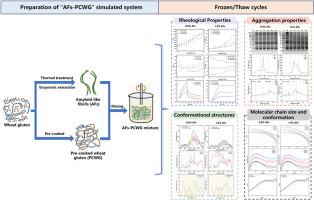淀粉样原纤维在冻融循环中加速预熟面筋解聚
IF 11
1区 农林科学
Q1 CHEMISTRY, APPLIED
引用次数: 0
摘要
本研究研究了热加工小麦面筋中淀粉样蛋白样原纤维(AFs)对冻融循环中预熟小麦面筋(PCWG)的影响。系统分析了其流变性能、分子量分布、构象结构、分子链大小和构象。主要研究结果表明,AFs的掺入加剧了FT处理下PCWG弹性和粘度的降低。值得注意的是,含1.0% AFs的PCWG的tan δ在1 Hz时增加到1.552,表明AFs诱导的相变从固体状态转变为流体状态。此外,AFs竞争性地与谷蛋白和麦胶蛋白亚基建立不可逆的共价交联,从而增强ft诱导的PCWG解聚。结构分析表明,引入1.0%的AFs后,FT处理后的PCWG中α-螺旋键和间扭式-间扭式二硫键的比例分别降至12.75%和22.41%。这些结果表明,AFs破坏了PCWG中氢键网络,破坏了二硫键的稳定性。此外,af的存在进一步加剧了ft诱导的分子链尺寸收缩;当AFs为1.0%时,经过10个FT循环后,PCWG的旋转半径减小到0.184 nm。总的来说,这些发现阐明了AFs在FT循环中加剧PCWG解聚的机制,并为优化冷冻熟面粉食品系统的质量提供了理论基础。本文章由计算机程序翻译,如有差异,请以英文原文为准。

Amyloid-like fibrils accelerate pre-cooked gluten depolymerization during freeze-thaw cycles
This study investigated the impact of amyloid-like fibrils (AFs), derived from thermally processed wheat gluten, on pre-cooked wheat gluten (PCWG) during freeze–thaw (FT) cycles. A systematic analysis was conducted encompassing rheological properties, molecular weight distribution, conformational structure, molecular chain size, and conformation. Key findings demonstrated that the incorporation of AFs exacerbated the reduction in elasticity and viscosity of PCWG under FT treatment. Notably, the tan δ of PCWG containing 1.0 % AFs increased to 1.552 at 1 Hz, indicating an AFs-induced phase transition from a solid-like to a fluid-like state. In addition, AFs competitively establish irreversible covalent cross-links with both glutenin and gliadin subunits, thereby intensifying FT-induced depolymerization of PCWG. Structural analyses revealed that the introduction of 1.0 % AFs reduced the proportions of α-helix and gauche–gauche–gauche disulfide bonds in PCWG after FT treatment to 12.75 % and 22.41 %, respectively. These results indicate that AFs disrupt the hydrogen bonding network and destabilize the stability of disulfide bonds in PCWG. Moreover, the presence of AFs further exacerbated the FT-induced contraction of molecular-chain dimensions; after 10 FT cycles, the radius of gyration of PCWG with 1.0 % AFs decreased to 0.184 nm. Collectively, these findings clarify the mechanism by which AFs exacerbate PCWG depolymerization during FT cycles and offer a theoretical foundation for optimizing the quality of frozen cooked flour-based food systems.
求助全文
通过发布文献求助,成功后即可免费获取论文全文。
去求助
来源期刊

Food Hydrocolloids
工程技术-食品科技
CiteScore
19.90
自引率
14.00%
发文量
871
审稿时长
37 days
期刊介绍:
Food Hydrocolloids publishes original and innovative research focused on the characterization, functional properties, and applications of hydrocolloid materials used in food products. These hydrocolloids, defined as polysaccharides and proteins of commercial importance, are added to control aspects such as texture, stability, rheology, and sensory properties. The research's primary emphasis should be on the hydrocolloids themselves, with thorough descriptions of their source, nature, and physicochemical characteristics. Manuscripts are expected to clearly outline specific aims and objectives, include a fundamental discussion of research findings at the molecular level, and address the significance of the results. Studies on hydrocolloids in complex formulations should concentrate on their overall properties and mechanisms of action, while simple formulation development studies may not be considered for publication.
The main areas of interest are:
-Chemical and physicochemical characterisation
Thermal properties including glass transitions and conformational changes-
Rheological properties including viscosity, viscoelastic properties and gelation behaviour-
The influence on organoleptic properties-
Interfacial properties including stabilisation of dispersions, emulsions and foams-
Film forming properties with application to edible films and active packaging-
Encapsulation and controlled release of active compounds-
The influence on health including their role as dietary fibre-
Manipulation of hydrocolloid structure and functionality through chemical, biochemical and physical processes-
New hydrocolloids and hydrocolloid sources of commercial potential.
The Journal also publishes Review articles that provide an overview of the latest developments in topics of specific interest to researchers in this field of activity.
 求助内容:
求助内容: 应助结果提醒方式:
应助结果提醒方式:


